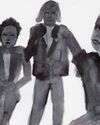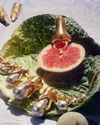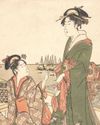The intermingling of men and robotic technology in the artistic realm paves the path ahead for the future of art.

THE CROSS-POLLINATION OF technology and art is no headliner. The convergence between the two dates as far back as the 1950s when artists and designers pioneered the use of computer programmes and mechanical devices. Even in the days when technology was in its infancy, it presented a sense of infinite possibilities conceivable beyond the confines of reality.
With time, technology has progressed exponentially, stretching the boundaries of imagination even further than the mind has ever reached. In the contemporary state of affairs, the evolution of the digital realm has one-upped itself with the creation and subsequent modifications of robots. Gradually, these machines are finding their place amongst people in the flesh — the artistic set, no exception.
Here, two artists unlock another dimension to their bodies of work through the aid of robots.
CHARLES AWEIDA
WHEN CHARLES AWEIDA was in graduate school at Carnegie Mellon University, he chanced upon the sizeable ABB six axis robot — essentially, a robotic arm — behind a glass window. It was love at first sight. Beguiled by the machine, Aweida’s artistic instinct set him on a path of investigation. While the robotic arm was primarily a tool employed under an architectural premise at the university, Aweida was instead intrigued by its applications in fine art.
Enrolling into the architecture course purely to gain access to the machine, Aweida spent his time in the course building an ecosystem to what would go on to become a universe within which his genre of work would reside. Aweida aptly describes himself as an half-and-half — equal parts artist and roboticist — bolstered by a diverse body of knowledge in a wide spanning repertoire of creative mediums that include architecture, industrial design, illustration, motion graphics, user interface design, creative coding, digital fabrication, photography, film and fine art.
この記事は T Singapore: The New York Times Style Magazine の August 2019 版に掲載されています。
7 日間の Magzter GOLD 無料トライアルを開始して、何千もの厳選されたプレミアム ストーリー、9,000 以上の雑誌や新聞にアクセスしてください。
すでに購読者です ? サインイン
この記事は T Singapore: The New York Times Style Magazine の August 2019 版に掲載されています。
7 日間の Magzter GOLD 無料トライアルを開始して、何千もの厳選されたプレミアム ストーリー、9,000 以上の雑誌や新聞にアクセスしてください。
すでに購読者です? サインイン

Look At Us
As public memorials face a public reckoning, there’s still too little thought paid to how women are represented — as bodies and as selves.

Two New Jewellery Collections Find Their Inspiration In The Human Anatomy
Two new jewellery collections find their inspiration in the human anatomy.

She For She
We speak to three women in Singapore who are trying to improve the lives of women — and all other gender identities — through their work.
Over The Rainbow
How the bright colours and lively prints created by illustrator Donald Robertson brought the latest Weekend Max Mara Flutterflies capsule collection to life.

What Is Love?
The artist Hank Willis Thomas discusses his partnership with the Japanese fashion label Sacai and the idea of fashion in the context of the art world.

The Luxury Hotel For New Mums
Singapore’s first luxury confinement facility, Kai Suites, aims to provide much more than plush beds and 24-hour infant care: It wants to help mothers with their mental and emotional wellbeing as well.

Who Gets To Eat?
As recent food movements have focused on buying local or organic, a deeper and different conversation is happening among America’s food activists: one that demands not just better meals for everyone but a dismantling of the structures that have failed to nourish us all along.

Reimagining The Future Of Fashion
What do women want from their clothes and accessories, and does luxury still have a place in this post-pandemic era? The iconic designer Alber Elbaz thinks he has the answers with his new label, AZ Factory.

A Holiday At Home
Once seen as the less exciting alternative to an exotic destination holiday, the staycation takes on new importance.
All Dressed Up, Nowhere To Go
Chinese supermodel He Sui talks about the unseen pressures of being an international star, being a trailblazer for East Asian models in the fashion world, and why, at the end of the day, she is content with being known as just a regular girl from Wenzhou.